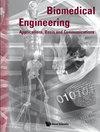EFFICIENT RETINAL IMAGE ENHANCEMENT USING MORPHOLOGICAL OPERATIONS
IF 0.6
Q4 ENGINEERING, BIOMEDICAL
Biomedical Engineering: Applications, Basis and Communications
Pub Date : 2022-07-20
DOI:10.4015/s1016237222500338
引用次数: 0
Abstract
Manual analysis of retinal images is a complicated and time-consuming task for ophthalmologists. Retinal images are susceptible to non-uniform illumination, poor contrast, transmission error, and noise problems. For the detection of retinal abnormalities, an efficient technique is required that can identify the presence of retinal complications. This paper proposes a methodology to enhance retinal images that use morphological operations to improve the contrast and bring out the fine details in the suspicious region. The enhancement plays a vital role in detecting abnormalities in the retinal images. Luminance gain metric ([Formula: see text] is obtained from Gamma correction on luminous channel of [Formula: see text]*[Formula: see text]*[Formula: see text] (hue, saturation, and value) color model of retinal image to improve luminosity. The efficiency and strength of the proposed methodology are evaluated using the performance evaluation parameters peak signal to noise ratio (PSNR), mean square error (MSE), mean absolute error (MAE), feature structural similarity index metric (FSIM), structural similarity index metric (SSIM), spectral residual index metric (SRSIM), Reyligh feature similarity index metric (RFSIM), absolute mean brightness error (AMBE), root mean square error (RMSE), image quality index (IQI), and visual similarity index (VSI). It has been revealed from the results and statistical analysis using the Friedman test that the proposed method outperforms existing state-of-the-art enhancement techniques.利用形态学操作有效增强视网膜图像
对眼科医生来说,人工分析视网膜图像是一项复杂而耗时的任务。视网膜图像易受光照不均匀、对比度差、传输误差和噪声问题的影响。为了检测视网膜异常,需要一种有效的技术来识别视网膜并发症的存在。本文提出了一种利用形态学操作提高对比度,突出可疑区域细节的视网膜图像增强方法。增强在视网膜图像异常检测中起着至关重要的作用。亮度增益度量([公式:见文])是通过对视网膜图像(色相、饱和度、值)颜色模型的[公式:见文]*[公式:见文]*[公式:见文]的发光通道进行Gamma校正,以提高亮度。利用峰值信噪比(PSNR)、均方误差(MSE)、平均绝对误差(MAE)、特征结构相似度指标(FSIM)、结构相似度指标(SSIM)、光谱残差指标(SRSIM)、Reyligh特征相似度指标(RFSIM)、绝对平均亮度误差(AMBE)、均方根误差(RMSE)、图像质量指标(IQI)、和视觉相似指数(VSI)。使用弗里德曼检验的结果和统计分析表明,所提出的方法优于现有的最先进的增强技术。
本文章由计算机程序翻译,如有差异,请以英文原文为准。
求助全文
约1分钟内获得全文
求助全文
来源期刊

Biomedical Engineering: Applications, Basis and Communications
Biochemistry, Genetics and Molecular Biology-Biophysics
CiteScore
1.50
自引率
11.10%
发文量
36
审稿时长
4 months
期刊介绍:
Biomedical Engineering: Applications, Basis and Communications is an international, interdisciplinary journal aiming at publishing up-to-date contributions on original clinical and basic research in the biomedical engineering. Research of biomedical engineering has grown tremendously in the past few decades. Meanwhile, several outstanding journals in the field have emerged, with different emphases and objectives. We hope this journal will serve as a new forum for both scientists and clinicians to share their ideas and the results of their studies.
Biomedical Engineering: Applications, Basis and Communications explores all facets of biomedical engineering, with emphasis on both the clinical and scientific aspects of the study. It covers the fields of bioelectronics, biomaterials, biomechanics, bioinformatics, nano-biological sciences and clinical engineering. The journal fulfils this aim by publishing regular research / clinical articles, short communications, technical notes and review papers. Papers from both basic research and clinical investigations will be considered.
 求助内容:
求助内容: 应助结果提醒方式:
应助结果提醒方式:


